ADDICTION
ALCOHOL DEPENDENCE
QUIT SMOKING
ALLERGY
ANTI FUNGAL
FUNGAL INFECTION
FUNGAL NAIL INFECTIONS
ANTI-REJECTION DRUGS
ANTI WORM
ANTIBIOTIC
BACTERIAL INFECTIONS
ARTHRITIS
GOUT
OSTEOARTHRITIS
RHEUMATOID ARTHRITIS
BLOOD
LOW PLATELET COUNT
THROMBOPHLEBITIS
VARICOSE VEINS
COLON
ANAL FISSURE
PILES
ULCERATIVE COLITIS
DIABETES CARE
DIABETES INSIPIDUS
DIABETES TYPE
DIABETIC FOOT ULCERS
GLUCOSE MONITOR
EYES/EAR CARE
DRY EYES
EYE CARE
EYE EXAMINATION
EYE INFECTION
EYE LASHES
EYE PAIN
GLAUCOMA
OCULAR HYPERTENSION
UVEITIS
FEVER CARE
MALARIA
RHEUMATIC FEVER
TYPHOID FEVER
GASTROINTESTINAL
ACIDITY
CONSTIPATION
CROHN'S DISEASE
DIARRHOEA
GALLBLADDER STONES
INTESTINAL ULCERS
IRRITABLE BOWEL SYNDROME
MOTION SICKNESS
NAUSEA
Atarax 10 mg (Hydroxyzine)
| Active Ingredient (Generic Name): | Hydroxyzine |
|---|---|
| Indication: | Allergic skin conditions, Anxiety |
| Manufacturer: | Dr Reddy’s Laboratories Ltd |
| Packaging: | 15 tablets in one strip |
| Strength: | 10 mg |
From: $44.00
Atarax 10 mg, a prescription medication, contains hydroxyzine hydrochloride. It alleviates symptoms of anxiety, itching, and allergic reactions by blocking histamine’s action during allergic reactions. This provides relief from itching caused by skin conditions and hives. Atarax 10 mg is effective in managing anxiety disorders, allowing individuals to resume daily activities. The oral dosage is 3 to 4 times a day, not exceeding 40 mg daily, with or without food.
Main Points
Atarax 10 mg is a prescription medication that contains 10 mg of hydroxyzine hydrochloride per tablet. It is used to alleviate anxiety and allergic reactions by blocking histamine action and modulating GABA activity.
The usual dosage is 3 to 4 times a day, not exceeding 40 mg daily. The medication should be taken orally with or without food as directed by a doctor.
Common side effects of Atarax 10 mg include drowsiness, dry mouth, and dizziness. Rare but serious side effects may include difficulty urinating and rapid heartbeat.
Atarax 10 mg tablets are available in pharmacies and online, with prices varying between $5 to $60 or more depending on the pharmacy and location.
What Is Atarax 10 mg?
Atarax 10 mg is a prescription-only medication containing hydroxyzine, an antihistamine used to treat anxiety, itching, and allergic reactions.
Hydroxyzine, the active ingredient, belongs to the antihistamine class of medications. Each tablet contains 10 mg of hydroxyzine hydrochloride.
To obtain Atarax 10 mg, a valid prescription from a healthcare professional is required. The medication is formulated to provide relief from symptoms associated with anxiety, itching, and allergic reactions.
When taken, hydroxyzine blocks the action of histamine, a chemical released by the body during an allergic reaction.
Uses and Benefits
Hydroxyzine alleviates symptoms of anxiety, itching, and allergic reactions, improving overall quality of life. Atarax 10 mg effectively manages anxiety disorders, reducing feelings of anxiety and fear, allowing individuals to feel more relaxed in stressful situations.
Hydroxyzine also treats itching caused by skin conditions like atopic dermatitis, urticaria, and contact dermatitis, providing quick relief and reducing the risk of skin infections. As an antihistamine, it treats allergic reactions, including hives, itching, and flushing, often prescribed for reactions to insect bites, food, or medications. By taking Atarax 10 mg, individuals can expect a reduction in symptoms, allowing them to resume daily activities without discomfort or distraction.
How It Works in Body
Hydroxyzine, the active ingredient in Atarax 10 mg, selectively binds to histamine receptors in the brain and peripheral tissues, blocking the action of histamine. This reduces the activity of histamine, diminishing the intensity of allergic reactions, anxiety, and itching sensations. As a result, symptoms such as hives, itching, and anxiety are alleviated.
Additionally, hydroxyzine‘s anticholinergic properties counteract the effects of acetylcholine, a neurotransmitter involved in nerve impulse transmission. This leads to decreased smooth muscle contractions, promoting relaxation and reduced anxiety. Hydroxyzine’s anxiolytic properties also modulate the activity of gamma-aminobutyric acid (GABA), a neurotransmitter regulating calmness and relaxation. Overall, hydroxyzine’s effects alleviate symptoms of anxiety, allergic reactions, and itching, promoting a sense of calmness and relief.
Dosage and Administration
Dosage and Administration
Take Atarax 10 mg orally, with or without food, as directed by your doctor. The usual dosage is 3 to 4 times a day, with a total daily dose not exceeding 40 mg. Follow the dosage instructions provided by your healthcare professional, as they may adjust the dosage based on your individual needs and response to the medication.
Swallow the tablet whole with a full glass of water. Do not crush, chew, or break the tablet, as this may affect the release of the active ingredient. You can take Atarax 10 mg with or without food, but take it at the same time each day to maintain a consistent level of the medication in your system.
Adhere to the prescribed dosage and administration schedule to achieve the desired therapeutic effect. If you miss a dose, take it as soon as you remember. Do not take a double dose to make up for the missed one. If you’re unsure about any aspect of taking Atarax 10 mg, consult your doctor or pharmacist.
Side Effects and Risks
Atarax 10 mg, like all medications, carries a risk of side effects. Common side effects include drowsiness, dry mouth, and dizziness. Headaches, fatigue, and stomach upset may also occur. In rare cases, more serious side effects may emerge, including difficulty urinating, rapid heartbeat, or allergic reactions such as hives or itching.
If you experience any of these symptoms, consult your doctor. Certain factors, such as age, other medical conditions, or interactions with other medications, may increase the risk of side effects. Your doctor will assess your individual situation and provide guidance on managing potential side effects.
To minimize the risk of adverse effects, follow the recommended dosage and administration instructions. If you have concerns or questions about side effects, discuss them with your doctor.
Precautions and Contraindications
Atarax 10 mg Precautions and Contraindications
Atarax 10 mg is contraindicated in patients with a prolonged QT interval. Caution is advised when prescribing it to individuals with a history of cardiac disease, glaucoma, or urinary retention. It is not recommended for patients with a history of hypersensitivity to hydroxyzine or cetirizine.
Elderly patients should be prescribed Atarax 10 mg with caution, as they may be more susceptible to adverse effects, particularly drowsiness and confusion.
Atarax 10 mg can cause drowsiness and impair cognitive function, which may affect the ability to operate heavy machinery or drive. Patients should avoid engaging in hazardous activities until they know how Atarax 10 mg affects them.
Consuming alcohol while taking Atarax 10 mg is not recommended, as it can exacerbate the sedative effects of the medication.
Understanding these precautions and contraindications is crucial for minimizing the risks associated with Atarax 10 mg and ensuring safe and effective treatment.
Interactions With Other Medications
Atarax 10 mg interactions with other medications can exacerbate its sedative effects or increase the risk of adverse reactions. Sedative properties may be additive when taking Atarax 10 mg with medications like benzodiazepines or barbiturates, increasing the risk of respiratory depression.
Caution is advised when taking Atarax 10 mg with medications that can cause drowsiness, such as muscle relaxants or anticonvulsants. Interactions may occur with medications that inhibit the cytochrome P450 enzyme, including macrolide antibiotics or azole antifungals, increasing the risk of adverse reactions.
It is essential to inform your healthcare provider about all medications, including prescription and over-the-counter medications, to minimize the risk of interactions. Your healthcare provider can help manage potential interactions and ensure safe and effective treatment.
Overdose and Toxicity
Overdose and Toxicity of Atarax 10 mg
Taking an overdose of Atarax 10 mg can result in severe sedation, respiratory depression, and even coma, particularly when combined with other central nervous system depressants.
Symptoms of an Atarax 10 mg overdose may include:
- Respiratory depression, which can lead to slowed breathing rate and respiratory failure
- Severe sedation, which can cause extreme drowsiness and loss of consciousness
- Coma, a state of deep unconsciousness that can be life-threatening
- Cardiovascular complications, including changes in heart rate and blood pressure that can lead to cardiac arrest
- Gastrointestinal symptoms, such as nausea, vomiting, and abdominal pain
If an overdose of Atarax 10 mg is suspected, immediate medical attention is necessary. A healthcare professional can provide supportive care, including activated charcoal administration, and monitor vital signs to prevent severe complications.
Common Brand Names
Atarax 10 mg is available under different brand names across regions. In the United States, it is marketed as Vistaril, while in Canada, it is known as Questran. In the UK, it is sold as Ucerax, and in Australia, it is marketed as Atarax or Risiko. Other brand names include Anatran and Novo-Hydroxyzine in various countries.
The active ingredient, hydroxyzine, remains the same across brand names. This means the medication’s effects, side effects, and interactions are identical regardless of the brand name. Patients should be aware of both the brand name and generic name of their medication to avoid confusion. Healthcare providers or pharmacists can provide information on the brand name and generic name of Atarax 10 mg prescriptions.
Storage and Disposal
Storage and Disposal
Proper storage of hydroxyzine tablets in a cool, dry place prevents degradation. Disposal of expired or unused medication through a drug take-back program or designated collection facility prevents environmental contamination. Follow the storage instructions provided by your pharmacist or healthcare provider and regularly check the medication’s expiration date.
Store hydroxyzine tablets in their original packaging or a tightly sealed container to protect them from moisture and light. Keep the medication out of reach of children and pets to prevent accidental ingestion. Avoid storing hydroxyzine tablets in the bathroom due to high humidity and temperature fluctuations that can cause degradation.
Check with local authorities or your pharmacist to find a drug take-back program or designated collection facility for disposing of expired or unused medication. Never flush hydroxyzine tablets down the toilet or dispose of them in the trash, as this can contaminate the environment.
Availability and Cost
Atarax 10 mg tablets are widely available in pharmacies and online pharmacies. The cost varies depending on location, insurance coverage, and pharmacy discounts. A valid prescription from a licensed healthcare professional is required for purchase.
The average cost of a 30-tablet supply of Atarax 10 mg is between $15 and $30 without insurance. Prices can range from $5 to $60 or more, depending on the pharmacy and location. Coupons, discount cards, or mail-order pharmacies may help reduce out-of-pocket costs. Insurance coverage may also cover part of the cost. It is essential to check with your insurance provider to understand your coverage and out-of-pocket expenses.
Frequently Asked Questions
Can I Take Atarax 10 mg During Pregnancy or Breastfeeding?
During pregnancy or breastfeeding, it is essential to exercise caution when taking medications. Consult your healthcare provider before taking any medication, as they can assess the risks and benefits. They will help you evaluate the potential effects on your baby’s health and development.
Can Atarax 10 mg Be Used to Treat Anxiety in Children?
Hydroxyzine, such as Atarax 10 mg, is not typically recommended for pediatric anxiety treatment due to limited research supporting its safety and efficacy in children. Instead, consult a pediatrician or child psychologist to discuss evidence-based treatments tailored to your child’s specific needs, such as cognitive-behavioral therapy or FDA-approved medications.
Does Atarax 10 mg Interact With Herbal Supplements or Vitamins?
When taking Atarax 10 mg, it is crucial to consult your healthcare provider before adding herbal supplements or vitamins to your regimen. Certain combinations can interact with your medication. Specifically, St. John’s Wort can increase the risk of serotonin syndrome. Vitamin C may also decrease the absorption of Atarax 10 mg. Always seek advice from your healthcare provider before adding any supplements or vitamins to your routine.
Can I Drive or Operate Heavy Machinery While Taking Atarax 10 mg?
When taking Atarax 10 mg, exercise caution before driving or operating heavy machinery. Drowsiness, dizziness, and blurred vision are potential side effects that can impair reaction time. Until you know how the medication affects you, avoid driving or operating heavy machinery. Start with a low dose and observe how your body reacts before engaging in these activities.
Is Atarax 10 mg Addictive and Can I Get Dependent on It?
Atarax 10 mg is a medication that can lead to physical dependence, especially with long-term use or high doses. Prolonged use can result in withdrawal symptoms if the medication is stopped abruptly. To minimize risks, it is essential to take Atarax 10 mg exactly as prescribed by a doctor. If discontinuation is necessary, consult a doctor about tapering off the medication to avoid potential withdrawal symptoms.
Conclusion
Atarax 10 mg contains hydroxyzine, a medication used to treat anxiety, itching, and sedation. It works by affecting the brain to reduce anxiety and itching. The typical dosage is 10-50 mg 2-4 times a day, taken orally. Possible side effects include drowsiness, dry mouth, and blurred vision. Overdose risks include seizures, coma, and death. Common brand names include Atarax and Vistaril. Store at room temperature, protected from light, and dispose of properly. Consult a doctor or pharmacist to determine if Atarax 10 mg is suitable for your needs.


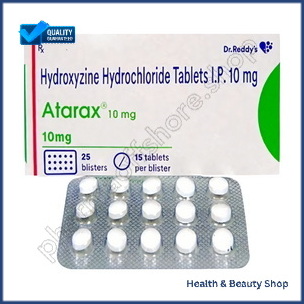
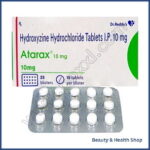
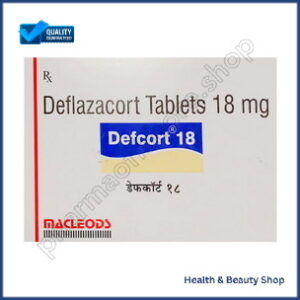

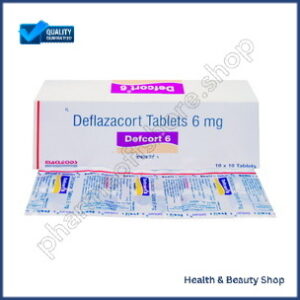
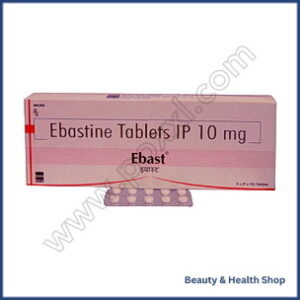
There are no reviews yet.